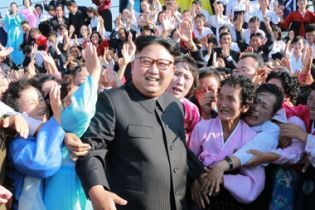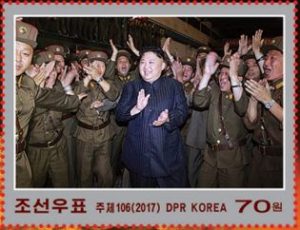North Korea’s Longest Missile Flight Ever Shows Guam is in Range

Pope to New Bishops: ‘Discernment’ Means Avoiding ‘Rigid’ Answers to Moral Questions
September 15, 2017
Ryan Anderson to Join Franciscan University of Steubenville as Visiting Fellow
September 15, 2017
A photo posted on an official regime propaganda site on Thursday shows Kim Jong-un being cheered by teachers. (Photo: Uriminzokkiri)
By Patrick Goodenough, CNSNews.com, September 15, 2017
The ballistic missile fired over Japan on Friday traveled further than any previously launched by the North Korean regime – about 2,300 miles (3,700 kilometers) – before splashing down in the northern Pacific.
That’s roughly 620 miles (1,000 kilometers) further than the Hwasong-12 medium-range missile Pyongyang fired over Japan 17 days ago. It’s also a longer flight than those of the first two rockets ever fired over Japan – by Kim Jong-un’s father, Kim Jong-il, in 1998 and 2009, both of which were described by the regime as attempt to put a satellite into space.
In the 1998 launch, the second of the two stages of a Taepodong-1 rocket landed some 200 miles east of Japan, or about 930 miles from the launch site. The projectile fired in 2009, a three-stage Unha carrier rocket, traveled just under 2,000 miles.
(Two intercontinental ballistic missiles tested in July have a longer range than the one fired on Friday, but both were launched in a steep upward trajectory, and so did not fly as far from their launch sites as the latest one.)
Like the Hwasong-12 launched on August 29, the latest one flew over Japan’s northern Hokkaido island, home to 5.5 million people.
If the missile fired on Friday was, as suspected, also a Hwasong-12, it carried a little short of the missile’s estimated maximum range of 2,484 miles (4,000 kilometers).
If confirmed, the 2,300 miles that it did travel demonstrates that the missile is capable of striking the U.S. territory of Guam, which lies roughly 2,110 miles (3,400 kilometers) south-east of Pyongyang.
Guam is the location of two strategic military bases, the Andersen Air Force base and Naval Base Guam. The island is also home to 163,000 people and there are about 6,000 military personnel stationed there.
The nearby Northern Mariana islands, a separate U.S. commonwealth that includes Saipan and Tinian, have a population of some 54,000.
North Korea last month threatened to fire ballistic missiles into “areas around Guam” in order to “neutralize” what it said was a U.S. military threat.
Guam’s homeland security office said Friday’s launch posed no immediate threat to the island or the Marianas.
“Our office will continue to work closely with our military and federal partners to monitor the situation and provide information in a timely manner,” said Guam homeland security advisor George Charfauros.
Fifteen hundred miles to the north, however, air raid sirens sounded and people were warned to take cover while early morning train services were suspended. Japanese Prime Minister Shinzo Abe called the launch an “outrageous act” and the Japanese and U.S. governments agreed to call for an emergency Security Council meeting later Friday.
It will be the third emergency council meeting on North Korea in 17 days. Previous ones were held on August 29 after the last time a missile was fired over Japan, and on September 4 in response to its nuclear test a day earlier.
 Images released by the North Korean regime this month show new postage stamps issued to celebrate its intercontinental ballistic missile tests in July. (Photo: Uriminzokkiri)
Images released by the North Korean regime this month show new postage stamps issued to celebrate its intercontinental ballistic missile tests in July. (Photo: Uriminzokkiri)A day before the latest launch, North Korea threatened to “reduce the U.S. mainland into ashes and darkness” and said Japan should be “sunken into the sea by the nuclear bomb” for spearheading and supporting U.N. Security Council resolution 2375 on Monday, imposing new sanctions in response to the nuclear test.




